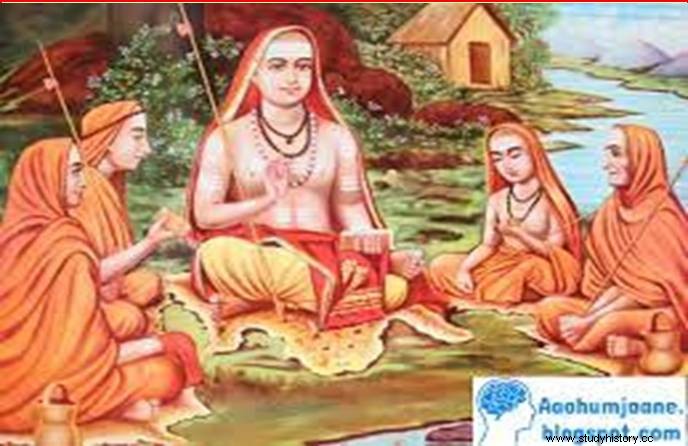
Economic life of Rigvedic Aryans
The economic life of the Rigvedic Aryans was simple, there was no complexity in it. The economy of the early Rigvedic Aryans was mainly pastoral, not food-producing, so regular taxes were collected from the people very little. There is no mention of donation of land or grain. Tribal ties were powerful in the society. Social classes had not yet come into existence based on the collection of taxes or on the basis of landed property. The economic condition of this period was as follows-
(1) Arrangement of Villages: The Rigvedic Aryans lived in villages. There is no mention of cities anywhere in the Rigveda. The villages were close by. For protection from wild animals and enemies, settlements with mud houses were fortified with bushes or other thorns etc. Most of the houses were made of bamboo and wood.
(2) Agriculture: Agriculture was the main occupation of the Rigvedic Aryans. Each family had a separate farm, but the pasture was the same for all. Farming was done with a plow. The mention of Phal is found in the early part of Rigveda. Their fruits were probably made of wood. The Rigvedic people were familiar with sowing, harvesting and threshing. He also had a good knowledge of different seasons. These people mainly cultivated wheat and barley. The Aryans of this period also produced fruits and vegetables.
(3) Animal Husbandry: The second major occupation of the Rigvedic Aryans was animal husbandry. The cow was the most important of the animals, because it was the most useful. The cow is called Adhyaya, that is, one who cannot be killed. It is proved by many mentions about cow in Rigveda that Aryans were cattle rearers. He fought most of the battles for the cows.
The word Gavishti is used for war in Rigveda. Which means 'search for cows'. The cow was considered the greatest asset. Oxen were used for plowing and pulling carts. Horses were used in chariots. Other animals domesticated by the Aryans were sheep, goats and dogs. Dogs guarded the houses and settlements.
(4) Hunting of Animals: Rigvedic Aryans used to eat meat. Therefore, hunting of wild animals was also their means of livelihood. These people hunted boars, deer and buffaloes with bows and arrows and iron spears and caught birds by trapping them. Lions were killed by being surrounded from all sides.
(5) Ware: Painted gray pottery and later Harappan pottery have been found from Bhagwanpura in Haryana and from three sites in Punjab. The items found in Bhagwanpura have been dated from 1600 BC to 1000 BC. The Rigveda was being composed during this period. The geographical area of these four places is the same as shown in the Rigveda.
Although painted gray vessels have been found at these four sites, neither iron material nor grains have been found from here. So we can think of a pre-iron stage of the painted gray pot, which is synchronous with the Rigvedic stage.
(6) Handcrafted Works: In the Rigveda, there are mentions of craftsmen like carpenters, chariots, weavers, tanners, potters etc. These show that the Aryans were well acquainted with these crafts. It is known from the word ayas used for copper or bronze that he had knowledge of metallurgy. They may have obtained copper from the Khetri mines of Rajasthan when they settled in the western part of the sub-continent. Carpenters of the Rigvedic period made chariots and carts.
These people also made wooden cups and made very good carvings on them. The craftsmen used to make various types of utensils, weapons and other useful items of copper and bronze. Goldsmiths used to make gold and silver ornaments. The tanners used to make leather goods. Sewing, weaving mats, making woolen and cotton clothes, etc. were also the means of livelihood. The potters used to make pottery on the wheel.
(7) Business: Trade was also a means of livelihood of the Rigvedic Aryans. These people used to do both foreign and internal trade. In the beginning trade was done by barter. Later on, the value of cow was started to be judged and finally currencies made of gold and silver started being used. During this period a currency called Nishk started being practiced. Cloth, leather and bed linen were the main items of trade. Cars and chariots were used to carry goods. Boats were used to cross the rivers.
(8) Lending Practice: In the Rigvedic period, there was a practice of giving loans on interest. Vaishyas, moneylenders and moneylenders used to do this work and it was their main means of livelihood. It was considered a religious duty to repay the loan and in case of non-payment, he had to serve the moneylender for a certain period of time.
Development of arts in Rigvedic society
Due to intellectual maturity, the people of the Rigvedic period developed a variety of creative arts. He was a true art lover.
(1) Poetry Art: The Rigvedic Aryans were very skilled in the art of poetry. Rigveda is written in verse style. Most of the poetry of Rigveda is religious lyric-poetry. There is naturalness and beauty in the poetry of this period. The sages have expressed great sentiment in the praise of Usha.
(2) Writing Art: It cannot be said with certainty whether Rigvedic Aryans were familiar with the art of writing or not, but many scholars like Dr. Bhandarkar etc. believe that they knew this art. The figures made on the pottery of that period look like Brahmi script.
(3) Other Arts: The Rigvedic Aryans were proficient in many other arts. He was so adept in the art of building houses that he used to build buildings of Sahasra-pillar and Sahasr-Dwar. The Rigvedic Aryans were also skilled in spinning, weaving, raging, metal-art, musical art, dancing and singing.
